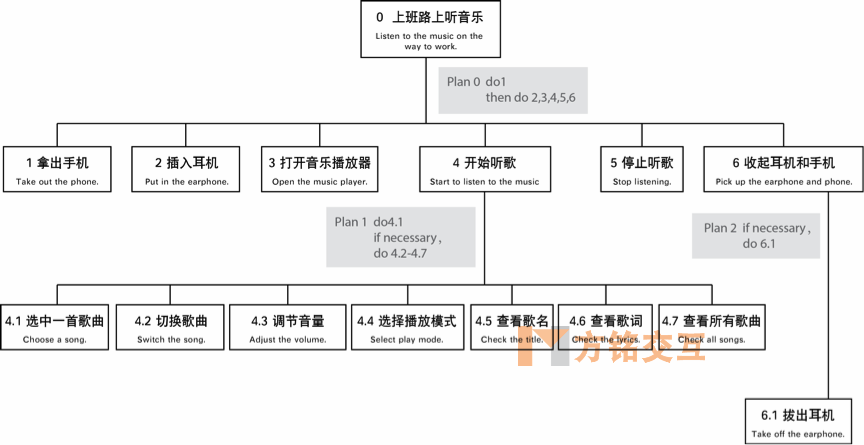通过任务分析了解用户使用产品时的目标和操作方式,习惯。一个详细的任务分析可以帮助理解现有的服务系统和里面的信息流,使得设计更合理和新系统的任务分配更准确,更有针对性。
Task analysis analyzes what a client is required to do in terms of actions or cognitive processes to achieve a task. A detailed task analysis can be conducted to understand the current service system and the information flows within it. Task analysis makes it possible to design and allocate tasks appropriately within the new system and the service interface can then be accurately specified.
(2)层次任务分解(HTA),另一种常用的任务分析的方法。它的目的是把任务分解成一个树状结构。以主任务为中心,不断地将任务分解成子任务,直到子任务很小或者不可能实现,希望通过这种形式能描绘出完成任务的顺序及条件。
The other one is hierarchical task analysis that is widely applied. The purpose of this method is to break the task down into a tree structure. It centers on the main task and constantly to break the task into subtasks until the subtasks is very small or impossible to achieve. It hopes that through this form can describe the sequence and conditions to complete the task.
案例背景:对上班路上听音乐这种行为进行分析。

案例说明Case description:
1、一张层次任务分解图需要表达出三种信息:用户的行为、行为之间的关系及某些行为发生的条件。
2、一个用户行为包含两方面的内容:编号和内容。在图示案例中,“上班路上听音乐”、“拿出手机”等都是对用户行为的描述,其中,“上班路上听音乐”是整个任务分解图的核心行为,因此他前面的编号为0,后面的行为依据顺序和层级关系分别标上1-6、4.1-4.7等编号。
3、通过线条和行为前的编号能够清楚地表达每个行为之间的关系。行为之间的关系包含了两方面的内容:行为顺序和层级关系。
4、不是所有行为都是必然发生的,为了更好地描述在完成主任务时可能有的行为,在必要的地方加上行为执行条件就是必须的了。有的时候,同一个层级的行为都是必须发生的,且按照顺序从头到尾;但很多时候,同一个层级的行为有的是必须发生的,而有的是可能发生的,这个时候就需要必须加以说明,如图示中的Plan1和Plan2。具体的格式规范参照图示案例。
适用于Apply for:
当分解的任务比较简单的时候,且目标是了解用户完成任务的流程和行为发生的条件的时候。